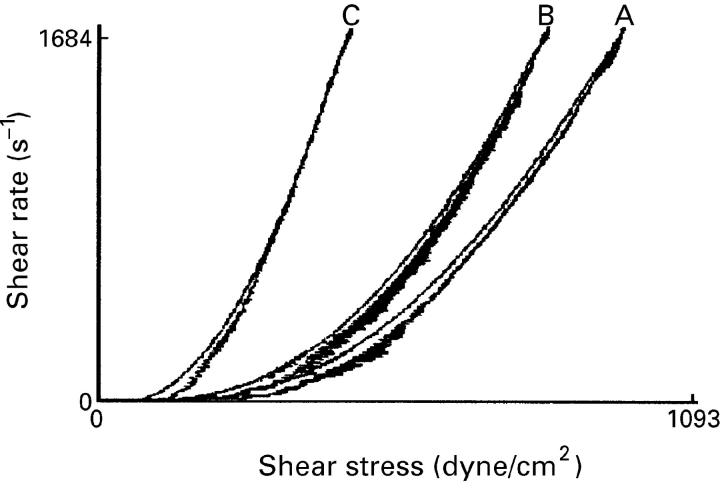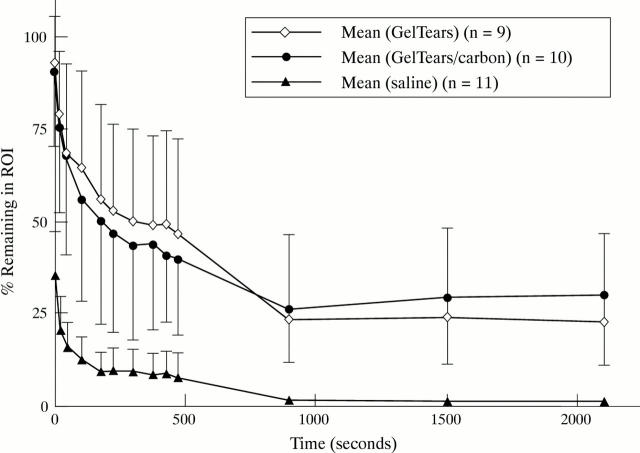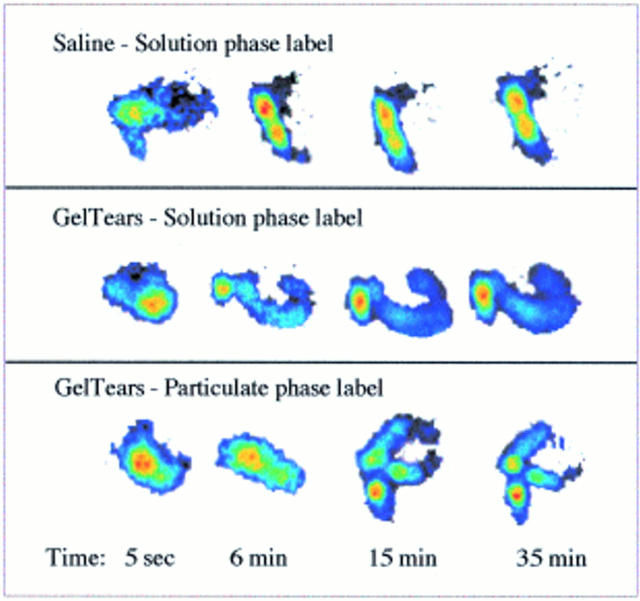Abstract
BACKGROUND/AIMS—Carbomers are widely used in products for the treatment of dry eye; however, the polymer gel thins on addition of probes (for example, fluorescein salt) confounding the comparison of products by objective clinical tests such as spectrophotofluorimetry or scintigraphy. A novel method of radiolabelling carbomer gels, with minimum change to their rheology, has permitted the non-invasive evaluation of precorneal residence of the gel in volunteers using gamma scintigraphy. The technique was used to evaluate the precorneal clearance of the liquid phase and of a suspended particulate in GelTears. METHODS—Low sodium technetium-99m labelled diethylenetriaminepentacetic acid (99mTc-DTPA) was used to label carbomer 940 gel, either adsorbed onto sterile charcoal to model an entrapped drug, or added directly to the gel to a final activity of 1 MBq per 25 µl dose. The clearance of the labelled gels was then compared with 99mTc-DTPA labelled saline in 12 volunteers. RESULTS—The addition of the low sodium radiopharmaceutical produced insignificant rheological changes in the gel compared with conventional 99mTc-DTPA labelling. The residence times on the eye of the gel formulations were significantly greater than that of the saline control. At 8 minutes postdosing, the label levels retained (mean (SD)) on the ocular surface were: saline, 7% (7%); 99mTc-DTPA gel, 42% (27%); and 99mTc-carbon gel, 42% (20%) of administered dose. There was no difference observed in the precorneal distribution between 99mTc-DTPA solution and particulate markers. CONCLUSIONS—These data demonstrate that carbomer based gels significantly extend contact of solutes or suspended solids with the corneal surface. The method of labelling does not significantly change the initial viscosity and is superior to previous methods which have used sodium salts (for example, sodium fluorescein) and therefore underestimate contact time. Keywords: carbomer gels; viscosity; ocular contact time; dry eye syndrome
Full Text
The Full Text of this article is available as a PDF (120.5 KB).
Figure 1 .
The effect of sodium ion on flow curves of GelTears. (A) GelTears, η'=1.93 cps; (B) GelTears with low sodium 99mTc-DTPA, η'=1.77 cps; and (C) GelTears with isotonic sodium 99mTc-DTPA, η'=0.72 cps, where η' is apparent viscosity at shear rate 1684 s-1. Note the addition of isotonic saline to the carbomer causes a marked reduction in apparent viscosity.
Figure 2 .
Mean corneal clearance of GelTears or saline formulations labelled with 99mTc-DTPA in the solution or particulate phase (mean (SD)).
Figure 3 .
Typical scintigraphic imagines of GelTears and saline control obtained during the study.
Selected References
These references are in PubMed. This may not be the complete list of references from this article.
- Greaves J. L., Wilson C. G., Galloway N. R., Birmingham A. T., Olejnik O. A comparison of the precorneal residence of an artificial tear preparation in patients with keratoconjunctivitis sicca and normal volunteer subjects using gamma scintigraphy. Acta Ophthalmol (Copenh) 1991 Aug;69(4):432–436. doi: 10.1111/j.1755-3768.1991.tb02018.x. [DOI] [PubMed] [Google Scholar]
- Marquardt R., Christ T. Untersuchungen zur Verweildauer von Tränenersatzmitteln. Klin Monbl Augenheilkd. 1986 Sep;189(3):254–257. doi: 10.1055/s-2008-1050799. [DOI] [PubMed] [Google Scholar]
- Snibson G. R., Greaves J. L., Soper N. D., Prydal J. I., Wilson C. G., Bron A. J. Precorneal residence times of sodium hyaluronate solutions studied by quantitative gamma scintigraphy. Eye (Lond) 1990;4(Pt 4):594–602. doi: 10.1038/eye.1990.83. [DOI] [PubMed] [Google Scholar]
- Unlü N., Ludwig A., van Ooteghem M., Hincal A. A. Formulation of Carbopol 940 ophthalmic vehicles, and in vitro evaluation of the influence of simulated lacrimal fluid on their physico-chemical properties. Pharmazie. 1991 Nov;46(11):784–788. [PubMed] [Google Scholar]





